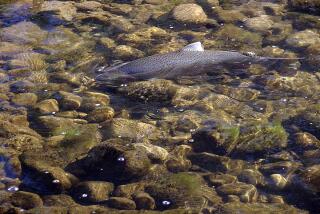Bald Eagles May Be Returned to Island Home
- Share via
Scientists are working to restore bald eagles to their rightful home off the Ventura County coast, returning them as early as this summer to their position as the primary predator on the northern Channel Islands.
“They belong on the islands,” said David Garcelon, an independent researcher coordinating the new project. “Santa Cruz [Island] could be the jump-off point.”
Collected, killed and, in the finishing blow, poisoned by the pesticide DDT, bald eagles disappeared from the islands almost 50 years ago--victims of the intrusion of man that has upset the natural balance of the islands.
Now, researchers hope to expand an eagle revival program begun on Catalina Island 20 years ago, and are counting on spending portions of a lawsuit settlement against the world’s largest DDT dump, a 100-ton underwater pool of the pesticide that has lingered for half a century on the ocean floor off Palos Verdes Peninsula.
Garcelon said he hopes to release 12 birds a year on Santa Cruz Island over a five-year period, with the idea that their breeding would provide a good start for the eagle population spreading through the rest of the chain. Those eagles could come from the breeding program at San Francisco Zoo or from wild populations in the Pacific Northwest.
The releases could begin as early as July at Santa Cruz Island, about 20 miles off the coast of Ventura, Garcelon said.
The National Parks Service considers the reintroduction of bald eagles an integral part of bringing the island back to its natural state.
In a kind of ecological domino effect, ranchers brought in pigs and allowed them to go wild over the course of a century, which, after the bald eagles died out, tempted mainland golden eagles to the island, where they preyed on the pigs and even easier pickings--the now rare island fox.
“You get to this critical point, and making a decision to save a species or not, you can bring it back to being a vital point of the ecosystem,” said Kate Faulkner, chief of natural resources management for Channel Islands National Park. “With some work, we can bring them back.”
But if the experience on Catalina Island is any indication, returning eagles to the wild could be a major challenge.
The undersea pool of DDT, which lies much closer to Catalina, has had long-lasting effects on that island’s eagle population. Their eggs tend to be very thin and easily crushed by eagle mothers. So Garcelon removes the eggs, replaces them with wooden ones, and then returns the babies after they’re hatched in a zoo.
There are now 15 to 19 of the birds on Catalina, including four breeding pairs, but some eaglets have died from residual poisoning. Garcelon and other environmentalists hope the off-shore spill will be capped soon, stemming the spread of the poison.
The initial program on the northern Channel Islands would be a study to determine whether bald eagles there would require the same egg exchange treatment scientists practice on Catalina. A model set up several years ago predicted similar treatment would be necessary, but scientists want to see if bald eagles feast on as many marine mammal carcasses--the primary carrier of the poison DDE, a byproduct of DDT.
“We want to see what would happen if we put the eagles out there, whether they’re picking up as much DDE as on Catalina,” said Laura Valoppi, a biologist with the U.S. Fish and Wildlife Service. “We feel that the best way to get the information is to release the birds and see what happens.”
Valoppi said the pilot program could last as many as five years before the eagles begin to breed, and that scientists will then decide whether to exchange their eggs.
Bald eagles have a history on the Channel Islands that ended with the widespread use of DDT in the 1950s, Valoppi said. According to records--which weren’t very carefully kept back then--Santa Cruz Island once had at least five eagle nests, and likely more. San Miguel, Santa Rosa and Anacapa islands all had at least three, according to conservative estimates, Valoppi said.
Some of the new eagles may reject nesting on the islands and choose homes on the mainland, a typical choice of the exploratory birds, but scientists are expecting some to return to nesting sites chosen by their ancestors.
The return of the bald eagle could be a boon to the island fox, a toy-sized canine with a photogenic face, because the majestic birds eat fish and other sea life. Once they establish rule on the island--and after golden eagles have been netted and relocated--researchers believe the golden interlopers will be kept away by bald eagles guarding their new turf.
“There are so few species [on the island], that when something happens, there’s a big ripple effect,” said Tim Coonan, a biologist with the parks service. “There’s a benefit just from an experimental perspective.”
Montrose Chemical Corp., which from 1947 to 1971 discharged an estimated 1,800 tons of DDT in Los Angeles County sewers and, from there, into the ocean, last year agreed to pay $145 million to settle a decade of lawsuits. Under the terms of one part of the settlement, $30 million will be used for projects chosen by state and federal agencies to restore damaged birds, fish and other natural resources.
The eagle repopulation plan, which would cost about $200,000 a year, must still go through a permit process, which would include a two-month public comment period.
“We’re champing at the bit,” said national park Supt. Tim Setnicka, who is on the committee that will decide how best to spend the Montrose money. “It’s going to happen.”
Parks officials say that if the bald eagles establish a home on the islands, it could be a substantial change--both for the ecology and for visitors who get a glimpse of the regal bald eagle.
“Fourteen pairs of bald eagles would be a fairly large presence,” said the park’s Faulkner. “It would make going to the islands a very different experience.”
More to Read
Sign up for Essential California
The most important California stories and recommendations in your inbox every morning.
You may occasionally receive promotional content from the Los Angeles Times.










